Hamsters
Understanding Ferrets: Do They Bite? Tips & Insight

Did you know that ferrets have sharp teeth and a tendency to nibble? Despite their adorable and cuddly exterior, these furry animals can be quite feisty. It may come as a surprise to some that ferrets are capable of biting, causing worries about their suitability as pets. However, fear not! We are here to offer insights into the intriguing realm of ferret behavior and offer helpful advice on how to manage and address biting habits.
Key Takeaways:
- Ferrets may bite for various reasons, such as exploration, teething, fear, dominance, or medical issues.
- Training kits from a young age can help prevent biting behavior and ensure proper socialization.
- Dealing with biting in adult ferrets may require patience, trust-building, and a safe environment.
- Fear biting in ferrets can be addressed through gentle approaches and reward-based training.
- Play biting can be redirected to appropriate toys, and understanding communication signals can prevent biting incidents.
Reasons Why Ferrets Bite
Ferrets are known for their playful and curious nature, but sometimes they might exhibit biting behavior. Understanding the reasons behind ferret biting is crucial for creating a safe and harmonious environment for both the ferret and its human companions. Let’s explore some common reasons why ferrets bite and how to address them effectively.
1. Biting during exploration: Kits, or baby ferrets, often nip as they use their mouths to explore their surroundings. This behavior is natural for them as they are curious about their environment. It is important to redirect their biting behavior towards appropriate toys and discourage them from nipping human skin.
2. Biting due to teething: Just like human babies, ferret kits go through a teething phase, which can cause discomfort. During this period, they might bite more frequently to alleviate teething pain. Providing them with suitable teething toys and frozen treats can help ease their discomfort and prevent them from biting inappropriate objects or people.
3. Biting out of fear: Some ferrets may resort to biting when they feel threatened or fearful. This behavior can be a defense mechanism to protect themselves. Taking a gentle and patient approach when handling fearful ferrets, and gradually exposing them to new experiences can help reduce their fear and minimize biting incidents.
4. Biting to assert dominance: Ferrets are social animals and have a hierarchical nature. In a group setting, they may bite to establish dominance or to communicate their position within the hierarchy. Proper socialization and supervision can help manage these behaviors and prevent aggressive biting.
5. Biting due to medical issues: Ferrets with certain medical conditions, such as dental problems or other sources of pain and discomfort, may resort to biting as a way to express their discomfort. It is important to have regular veterinary check-ups and address any underlying health issues promptly to prevent biting associated with pain.
Ferret Biting Behavior: A Comprehensive Overview
Understanding and addressing ferret biting behavior requires patience, observation, and providing appropriate outlets for natural behaviors. By identifying the underlying cause of biting, whether it’s exploration, teething, fear, dominance, or medical issues, you can take proactive steps to prevent and manage biting incidents. Positive reinforcement, proper handling techniques, and creating a safe and stimulating environment are integral in fostering a harmonious relationship with your ferret.
| Reasons | Description |
|---|---|
| Exploration Biting | Kits may nip during exploration |
| Teething | Kits may bite to alleviate teething discomfort |
| Fear | Ferrets may bite when feeling threatened or fearful |
| Dominance | Ferrets may bite to establish dominance |
| Medical Issues | Biting can be a result of pain or discomfort |

Training Kits to Prevent Biting
When it comes to preventing biting behavior in ferrets, training is key, especially when they are young kits. By starting their training early on, we can effectively discourage biting and set the foundation for a well-behaved and socialized ferret. Patience and consistency are essential during this process. Remember, each kit is unique and will learn at their own pace, so it is important to approach their training with understanding and flexibility.
Socializing kits and teaching them appropriate interaction with humans is a critical component of preventing biting. Introducing them to various environments, people, and experiences helps them become familiar with different stimuli and reduces their likelihood of feeling threatened or fearful. By exposing them to positive, controlled social situations, we can help them develop confidence and minimize aggressive behavior.
Positive reinforcement techniques are particularly effective when training kits to prevent biting. Using rewards such as treats or verbal praise when they display calm and non-biting behavior reinforces the desired actions. This approach encourages them to associate positive experiences with appropriate interactions, further reinforcing good behavior. On the other hand, it is crucial to avoid any form of punishment or aggression during training, as this can escalate fear or anxiety and lead to even more biting.
Sample Training Schedule for Kits
Here is a sample training schedule to help you get started with preventing biting behavior in kits:
- Handle the kit gently and provide a safe, comfortable environment for interaction.
- Introduce the kit to new sights, sounds, and smells gradually, ensuring they feel secure.
- Offer treats and praise when the kit displays calm and non-biting behavior.
- Redirect their attention to appropriate toys or objects when they show signs of wanting to bite.
- Consistently reinforce positive behaviors and discourage biting by immediately removing attention or redirecting focus when they exhibit biting behavior.
- Practice regular socialization with supervised playdates or visits to other ferret-friendly homes.
- Continue training and reinforcing positive behavior as the kit grows, adjusting the training techniques based on their progress and individual needs.
Remember, training kits to prevent biting is an ongoing process that requires dedication and patience. By using positive reinforcement, socialization, and consistent training, you can help your kit develop into a well-behaved and gentle ferret.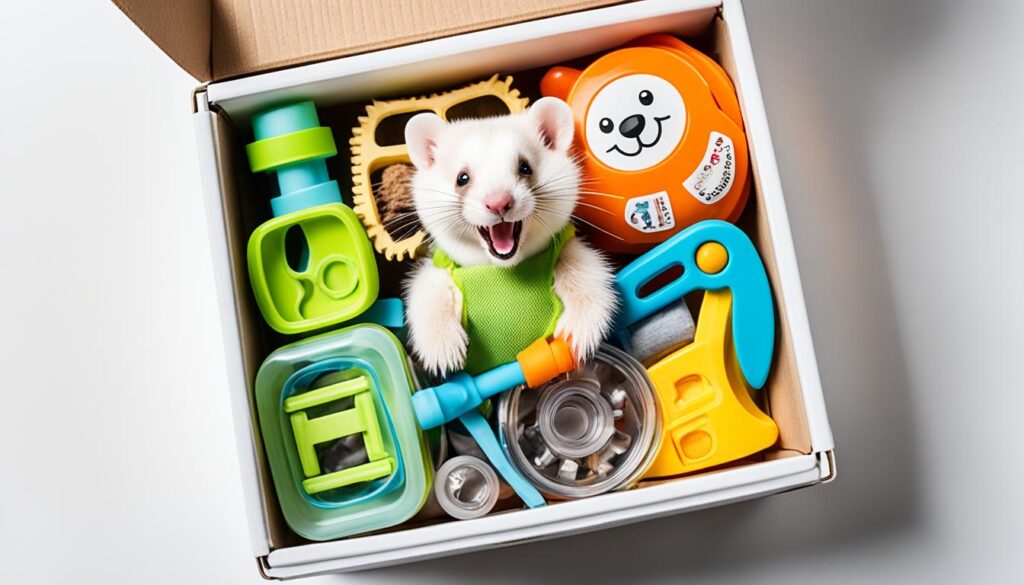
Dealing with Biting in Adult Ferrets
When it comes to adult ferrets displaying biting behavior, it may require more time and effort to address their habits effectively. However, with proper handling, trust-building, and creating a safe environment, you can help prevent biting in adult ferrets.
To address biting in adult ferrets, it is essential to approach the situation with patience, firmness, and gentleness. Remember, ferrets are intelligent creatures that respond well to positive reinforcement techniques.
Proper Handling
One of the key factors in dealing with biting behavior is learning how to handle adult ferrets properly. By supporting their body and minimizing sudden movements or reactions, you can help them feel secure and reduce the likelihood of biting. Gentle and careful handling is crucial to establish trust and prevent fear-based biting.
Building Trust
Building trust with adult ferrets is vital in curbing their biting tendencies. Take the time to spend quality bonding moments with them, such as playing and providing treats. By consistently showing them love, care, and respect, you can foster a stronger bond and minimize biting behavior.
Creating a Safe Environment
Providing a safe and secure environment is essential for adult ferrets. Ensure that their living space is free from potential hazards and stressors that may trigger biting behavior. A well-designed and enriched environment, with plenty of toys and mental stimulation, can also reduce boredom and the likelihood of biting.
Remember, adult ferrets may require additional time and effort to overcome biting habits. With patience, consistency, and a gentle approach, you can work towards minimizing biting behavior in adult ferrets and create a harmonious relationship based on trust and mutual respect.
Fear Biting in Ferrets
Some ferrets may exhibit fear biting due to past traumatic experiences or lack of confidence. Fearful ferret behavior can be challenging to address, but with patience and proper techniques, it is possible to help them overcome their fears.
When dealing with fear biters, it is important to approach them gently and create an environment of trust. Avoid making sudden movements or loud noises that may startle or trigger their fear response.
One effective method to address fear biting is through reward-based training. By using positive reinforcement techniques, such as treats and praise, you can gradually build their confidence and associate positive experiences with human interaction.

Acclimation techniques can also be helpful in reducing fear biting behavior. Introduce new experiences and environments slowly, allowing the ferret to become familiar and comfortable at their own pace.
To illustrate these approaches, refer to the following table that outlines strategies for addressing fear biting in ferrets:
| Techniques to Address Fear Biting | Benefits |
|---|---|
| 1. Gentle and patient approach | – Builds trust and reduces fear |
| 2. Reward-based training | – Associates positive experiences with human interaction |
| 3. Gradual acclimation to new experiences | – Reduces anxiety and fosters confidence |
By implementing these techniques and providing a supportive environment, ferret owners can help fearful ferrets overcome their fears and reduce fear biting behavior.
Play Biting in Ferrets
Ferrets are known for their playful nature, and play biting is a common behavior exhibited during playtime. When ferrets play, they may occasionally nip or gently bite as a form of interaction. Understanding this behavior is essential for both the ferret’s well-being and the owner’s enjoyment of playtime.
Play biting is different from aggressive biting, which is characterized by a ferret biting with force, aggression, or intention to harm. Play biting, on the other hand, is usually gentle and does not cause harm or pain.
To manage play biting effectively, it is important to establish clear boundaries and redirect the ferret’s biting behavior onto appropriate toys or objects instead of human skin. This can be achieved by providing a variety of interactive toys and engaging in play sessions with the ferret.
“Redirecting the ferret’s biting behavior onto appropriate toys or objects instead of human skin is key to managing play biting effectively.”
When the ferret playfully bites during playtime, it is best to ignore the behavior. Reacting strongly by shouting or pulling away may inadvertently reinforce the behavior, as it provides attention and interaction. Instead, remain calm and still, avoiding any sudden movements that may excite the ferret further. By withholding attention, the ferret learns that biting does not elicit the desired response.
Once the ferret stops biting and exhibits calm behavior, reward them with praise and treats. Positive reinforcement helps to reinforce desirable behavior and can help deter play biting in the long run.
In addition to redirecting and rewarding, it is important to provide ample opportunities for exercise and mental stimulation. Ferrets have high energy levels and need regular play sessions to channel their energy in a positive way. Engaging in interactive play, such as chasing toys or playing hide-and-seek, can help satisfy their instinct to play and reduce play biting tendencies.
“Regular play sessions and ample opportunities for exercise can help reduce play biting tendencies in ferrets.”
Remember, ferrets are social animals, and play is an essential part of their daily routine. By understanding and managing play biting behavior appropriately, we can foster a harmonious and enjoyable playtime experience with our ferret companions.
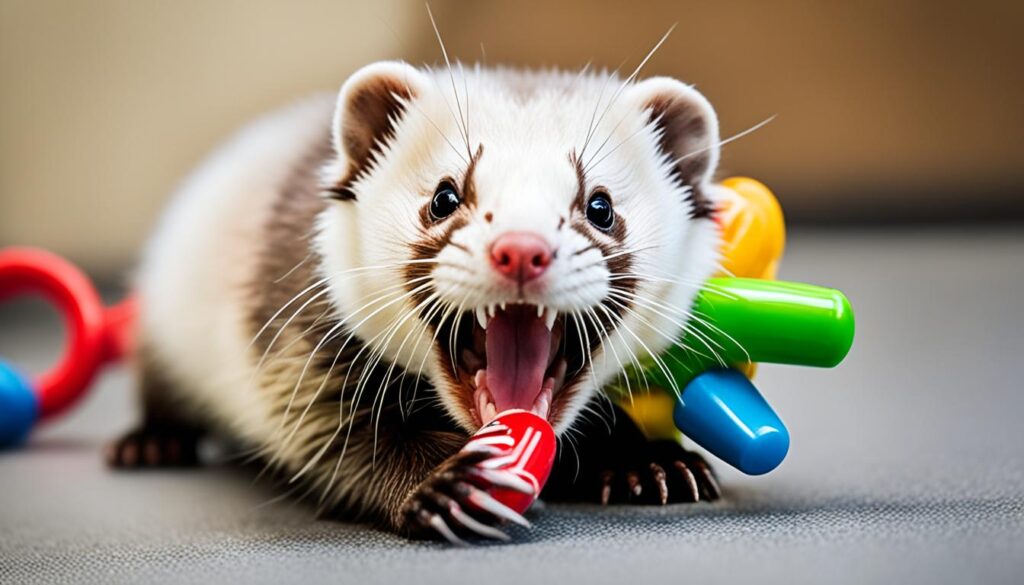
| Tips for Managing Play Biting in Ferrets |
|---|
| Establish clear boundaries and redirect biting onto appropriate toys or objects. |
| Ignore play biting when it occurs, avoiding any strong reactions. |
| Reward calm behavior and provide positive reinforcement. |
| Engage in regular play sessions to satisfy their high energy levels. |
Communication Signals and Biting
Ferrets have a unique way of communication, and sometimes biting is used as a means to convey their messages. However, it’s important to note that biting isn’t the sole form of communication for ferrets. They also exhibit various other signals to express their needs and emotions. By understanding these communication signals and promptly responding to them, you can prevent biting episodes in your ferret and maintain a harmonious bond.
Nuzzling:
One common communication signal that ferrets use is nuzzling. It’s their way of seeking attention or affection from their owners. Nuzzling can be accompanied by chirping noises or gentle paw touches. By recognizing these gestures, you can fulfill your ferret’s need for interaction, reducing the likelihood of biting.
Waiting for Attention:
Ferrets often exhibit patience to get what they want. You may notice your ferret sitting calmly or following you around, waiting for your attention. This is a clear indication that they want to engage with you. By acknowledging their presence and spending quality time together, you can satisfy their need for companionship and decrease the likelihood of biting.
“Understanding and responding to your ferret’s communication signals is crucial in preventing biting incidents. By recognizing the subtle cues they display, such as nuzzling and waiting for attention, you can fulfill their emotional needs and build a strong bond built on trust and understanding.”
It’s important to note that every ferret may have its unique set of communication signals. Observing your ferret’s behavior and being attentive to their needs will help you develop a deeper understanding of their specific signals. By responding appropriately and providing a nurturing environment, you can effectively prevent biting and foster a happy and communicative relationship with your ferret.
When your ferret communicates through behaviors other than biting, it’s crucial to respond promptly and address their needs. By doing so, you establish a clear line of communication and create a bond of trust and understanding.
Next, let’s take a look at some preventive measures you can implement to reduce the likelihood of biting incidents in your ferret.
Preventive Measures for Biting
When it comes to preventing biting in ferrets, proactive measures can go a long way in ensuring a safe and harmonious environment. By providing appropriate care and addressing their natural behaviors, you can minimize the likelihood of biting incidents.
1. Enrichment and Toys
Ferrets are active and intelligent animals that require mental and physical stimulation. Providing a variety of toys and outlets for their natural behaviors can help prevent boredom and frustration that may lead to biting. Toys such as tunnels, puzzles, and interactive games can engage their curiosity and keep them entertained for hours.
2. Regular Socialization
Regular socialization is essential for ferrets. Exposing them to different environments, people, and animals from a young age can help them become more comfortable and less likely to bite out of fear or anxiety. Gradual introductions and positive experiences during socialization can build their confidence and reduce aggressive tendencies.
3. A Safe and Stimulating Environment
Creating a safe and stimulating environment is crucial for preventing biting. Ferrets need plenty of space to explore, climb, and play. Ensure their enclosure is secure, free of potential hazards, and offers different levels and hiding spots. Additionally, providing a consistent routine and opportunities for exercise can help alleviate pent-up energy that may trigger biting behavior.
4. Consistent Positive Reinforcement Training
Positive reinforcement training is effective in shaping desirable behavior and discouraging biting. Rewarding good behavior, such as gentle interactions and appropriate play, can reinforce positive habits. Conversely, it is important to avoid punishment or aggression, as it can lead to fear-based biting and damage the ferret-owner relationship.
5. Ferret-Safe Households
Creating a ferret-safe household is crucial for their well-being and preventing biting incidents. Ferret-proofing your home by blocking off small spaces, securing electrical cords, and removing potential hazards can help minimize the risk of accidents or injuries that may trigger defensive biting.
6. Veterinary Care
Maintaining regular veterinary care is essential for ferret health. Regular check-ups can help identify any underlying medical conditions that may cause pain or discomfort, leading to biting behavior. Addressing these health issues promptly can alleviate their discomfort and reduce the likelihood of biting.
| Preventive Measures for Biting | Description |
|---|---|
| Enrichment and Toys | Provide a variety of toys and outlets for natural behaviors. |
| Regular Socialization | Expose ferrets to different environments, people, and animals. |
| A Safe and Stimulating Environment | Create a secure environment with ample space and mental stimulation. |
| Consistent Positive Reinforcement Training | Use positive reinforcement to shape desirable behavior and discourage biting. |
| Ferret-Safe Households | Ferret-proof your home to minimize potential hazards. |
| Veterinary Care | Maintain regular check-ups to address any underlying medical conditions. |
By implementing these preventive measures, you can create a safe and comfortable environment for your ferret, reducing the likelihood of biting. Remember that each ferret is unique, so it’s important to observe their behavior, provide them with appropriate care, and seek professional advice if needed.
Handling Ferrets Safely
Proper handling techniques are vital for ensuring the safety of both ferrets and their handlers. By following these guidelines, you can prevent biting incidents and establish a trusting relationship with your ferret.
When handling a ferret, it’s important to support their body, especially their back end, to help them feel secure. Avoid any sudden movements or reactions as these may startle the ferret and increase the likelihood of biting. Remember, gentle and calm handling is key to building trust.
Here are some tips for safe ferret handling:
- Approach with care: Before picking up a ferret, make sure they are calm and relaxed. Approach them slowly and speak softly to let them know you mean no harm.
- Support their body: When lifting a ferret, place one hand under their chest and the other hand under their hind end. This way, you can provide stability and support to prevent any accidental falls or injuries.
- Avoid restrictive holds: Refrain from squeezing or restraining a ferret tightly. They need freedom of movement to feel comfortable and secure.
- Know their comfort zones: Observe your ferret’s body language and respect their personal space. Some ferrets may not enjoy being held for long periods, while others may feel more relaxed when wrapped in a towel or blanket.
Remember, each ferret is unique, and it’s essential to understand their individual preferences and comfort levels. Taking the time to handle your ferret gently and with care will help to establish a bond based on trust and prevent fear-based biting.
In the words of ferret enthusiast Byron O’Conner:
“Ferrets are incredibly agile and delicate creatures. Handle them with love and respect, and they will reward you with their playful nature and unwavering affection.”
| Handling Tips | Benefits |
|---|---|
| Gently support the ferret’s body | Prevents accidental falls and injuries |
| Avoid sudden movements or reactions | Reduces the likelihood of biting due to fear or stress |
| Respect their personal space | Helps establish trust and a sense of security |
| Observe their comfort zones | Allows for individual preferences and reduces anxiety |
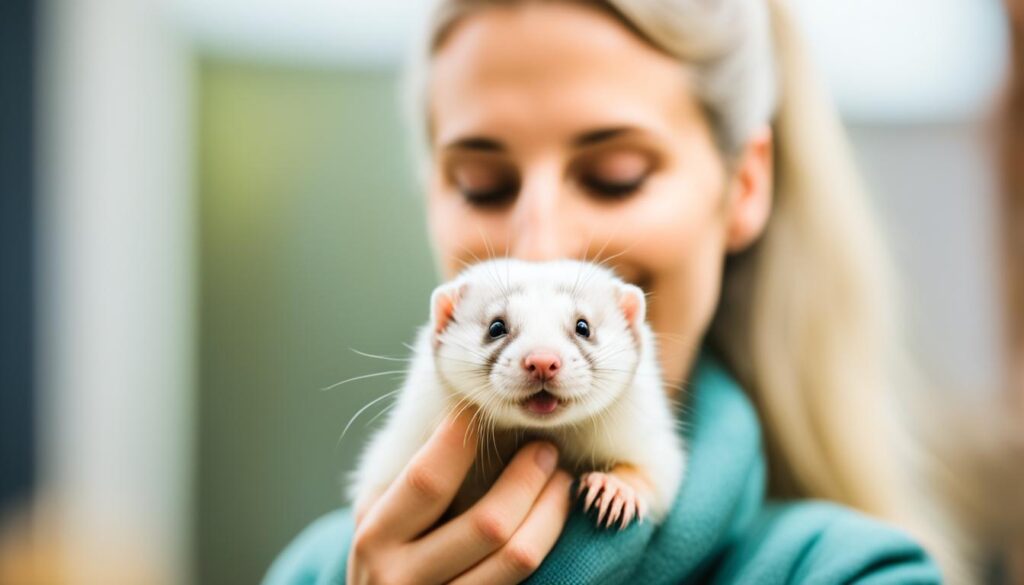
Ferret Behavior: Frolicking and Sleeping Patterns
Understanding ferret behavior is essential for fostering a strong bond with your furry companions. As pet owners, it’s important to navigate their interactions with insight into their unique characteristics. Ferrets are known for their playful frolicking, which is an expression of joy and excitement. Witnessing their energetic leaps and bounds can bring a smile to anyone’s face.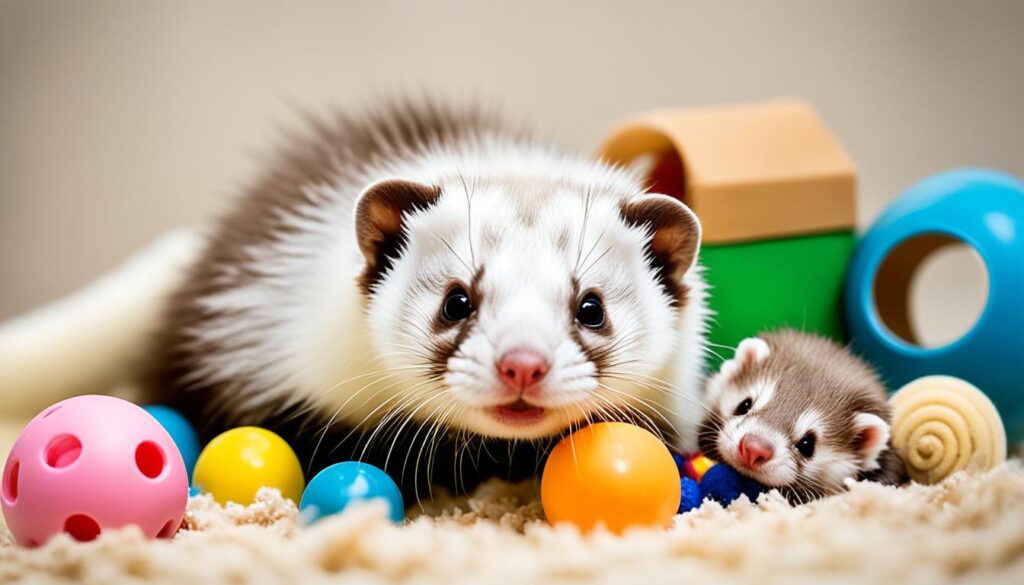
Additionally, ferrets have distinct sleeping patterns that may surprise some pet owners. They often fall into deep, relaxed sleep, which can sometimes be mistaken for unconsciousness. During these resting periods, their bodies become limp, their breathing slows down, and they may even twitch or make small noises. It’s essential to understand and appreciate these natural behaviors to provide appropriate care and support for your ferrets.
Conclusion
Understanding ferrets and preventing biting behavior is crucial for building a strong bond with these playful and affectionate companions. By taking a patient and consistent approach, while considering their natural behaviors, we can create a safe and harmonious environment for our furry friends.
To prevent biting, it is important to address the underlying causes. Whether it’s teething, fear, or communication, identifying the root cause will help us implement the right training techniques. Positive reinforcement training, along with regular socialization and a stimulating environment, can go a long way in preventing biting and creating a trusting relationship.
Proper handling is also a key factor in preventing biting incidents. By gently supporting their bodies and minimizing sudden movements, we can help our ferrets feel secure and reduce the likelihood of fear-based biting. By understanding their unique behaviors, such as frolicking and sleeping patterns, we can provide them with the care they need.
In conclusion, with understanding, patience, and proper training techniques, we can ensure that our ferrets become wonderful companions without excessive biting behavior. By taking these preventive measures, we can create a bond built on trust, respect, and a mutual understanding of each other’s needs.FAQ
Do ferrets bite?
What are the reasons why ferrets bite?
How can I train kits to prevent biting?
How can I deal with biting in adult ferrets?
What should I do about fear biting in ferrets?
How can I prevent play biting in ferrets?
Why do ferrets use biting as a means of communication?
What preventive measures can I take to reduce biting in ferrets?
How can I handle ferrets safely to prevent biting?
What should I know about ferret behavior, such as frolicking and sleeping patterns?
As our Editor-in-Chief, James plays a pivotal role in ensuring the quality and integrity of our content. With a keen eye for detail and a passion for storytelling, James oversees the editorial process here at A Place for Animals. With years of experience in content editing, James ensures that every piece of content meets our high standards of accuracy and clarity. Under James’ guidance, you can rest assured that the content you read is informative and impeccably crafted.
Hamsters
How Hamsters Can Safely Eat Bell Peppers: A Guide
An essential guide on safely feeding bell peppers to hamsters, ensuring their health and enjoyment – discover the key tips here!
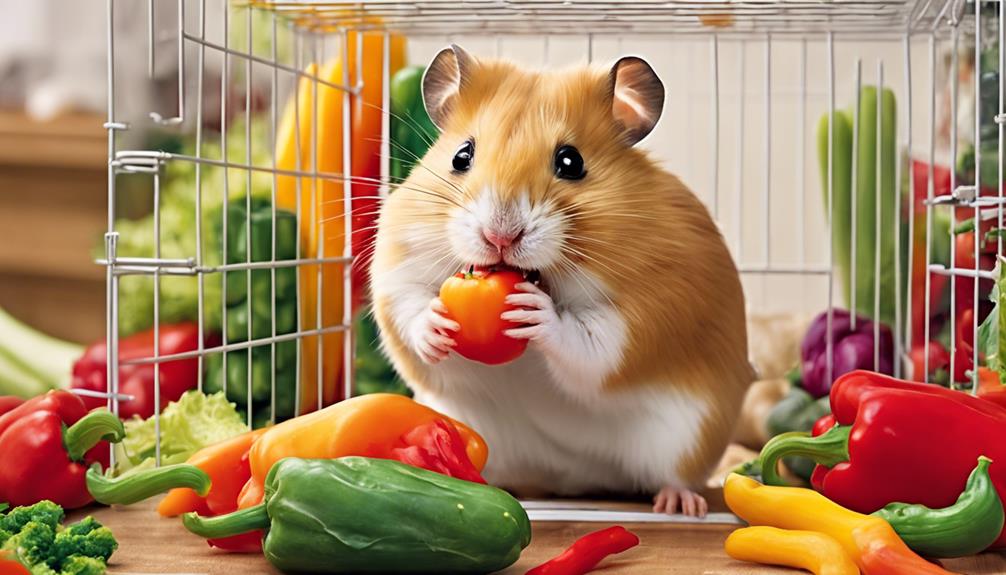
When giving bell peppers to hamsters, it is essential to prioritize their safety and health. We suggest washing the peppers thoroughly to eliminate any pesticides, removing the seeds and stems to prevent choking risks, and cutting them into small, bite-sized pieces for easy eating. Stick to red, yellow, and green sweet peppers as they are safe and nutritious, while avoiding hot or chili peppers.
Remember to offer bell peppers in moderation, monitor for any digestive issues, and remove uneaten portions promptly. By following these guidelines, hamsters can enjoy bell peppers as a healthy treat.
Key Takeaways
- Wash bell peppers thoroughly to remove pesticides before feeding.
- Remove seeds and stem to prevent choking hazards.
- Cut bell peppers into small, bite-sized pieces for easy consumption.
- Offer red, green, or yellow sweet peppers; avoid hot varieties.
- Feed bell peppers in moderation, 2-3 times a week to prevent overconsumption.
Benefits of Bell Peppers for Hamsters
Bell peppers offer numerous health benefits for hamsters, making them a valuable addition to their diet. These vibrant veggies are packed with Vitamin C, crucial for boosting a hamster's immune system. The fiber content in bell peppers supports proper digestion for our furry friends, ensuring their tummies stay happy and healthy. Additionally, the antioxidants found in bell peppers can help reduce the risk of diseases in hamsters, keeping them strong and vibrant.
Moreover, bell peppers contain pantothenic acid, which plays a vital role in the production of healthy blood cells for hamsters. This nutrient is essential for overall well-being and vitality. Furthermore, the iron present in bell peppers can help prevent anemia in hamsters, ensuring they maintain optimal health. By incorporating bell peppers into their diet, hamsters can enjoy a range of benefits that contribute to their overall wellness, from a robust immune system to healthy blood cell production.
Proper Bell Pepper Preparation for Hamsters

When preparing bell peppers for hamsters, it's essential to ensure they're thoroughly washed to remove any pesticides or dirt before feeding them to our furry friends. Washing the bell peppers under running water and scrubbing gently with a brush can help eliminate any harmful substances that may be present on the skin. Additionally, it's crucial to remove the seeds and stem from the bell peppers as they can pose a choking hazard to hamsters.
Cutting the bell peppers into small, bite-sized pieces is also important to make it easier for hamsters to eat and digest. Offering fresh bell peppers instead of cooked or processed ones ensures that hamsters receive the maximum nutritional benefits from this healthy treat. Remember to monitor your hamsters while they eat bell peppers to ensure they're chewing properly and not experiencing any digestive issues.
Safe Bell Pepper Varieties for Hamsters
After ensuring proper preparation of bell peppers for hamsters, selecting safe varieties is crucial for their well-being and health. When considering the best bell pepper options for your furry friend, keep the following in mind:
- Red Bell Pepper: Red sweet peppers are a safe and nutritious choice for hamsters. They're rich in healthy nutrients and provide a tasty treat that your pet will enjoy.
- Green Peppers: Green peppers are also a suitable option for hamsters. They've a milder taste compared to red or yellow peppers, making them a great addition to your hamster's diet.
- Safe Pepper Varieties: Stick to red, yellow, and green sweet peppers as hot or chili peppers can be harmful to hamsters. Ensuring you offer the right type of pepper is essential for your pet's well-being.
- Nutritional Value: Bell peppers have high water content and essential nutrients that can contribute to proper bowel function and overall health for your hamster. Incorporating these safe pepper varieties into your hamster's diet can be beneficial.
Moderation Tips for Feeding Bell Peppers
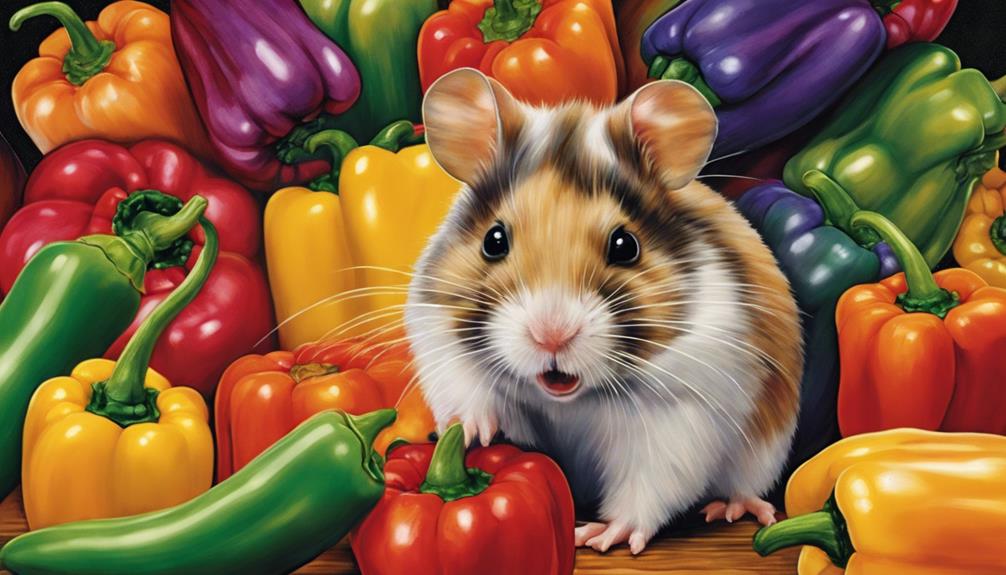
To maintain a healthy diet for your hamster, it's important to offer small slices of bell pepper in moderation, typically 2-3 times a week to prevent overconsumption and digestive issues. When feeding your hamster bell peppers, remember that moderation is key. Both green and red bell peppers can be included in your hamster's diet as a source of essential nutrients.
It's essential to monitor your hamster for any signs of digestive issues like diarrhea or bloating after adding bell peppers to their diet. Additionally, removing any uneaten bell peppers within 12 hours is crucial to prevent spoilage and potential health risks.
Before feeding, ensure that the bell peppers are washed thoroughly to eliminate any pesticides or dirt that may be present. By following these moderation tips and providing bell peppers as a treat in a balanced manner, you can ensure that your hamster remains healthy and content.
Nutritional Guidelines for Hamsters
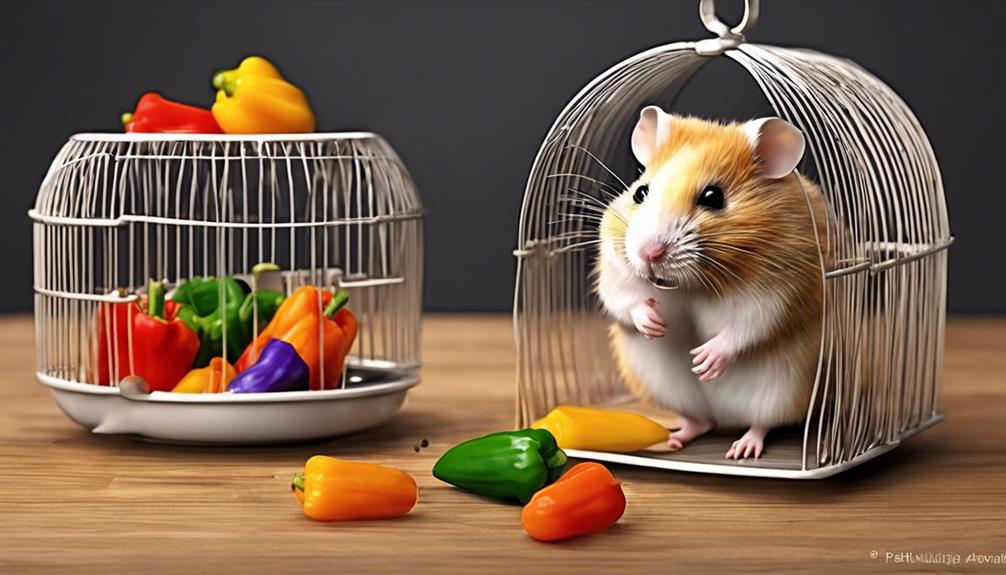
Our hamsters' nutritional requirements can be met by incorporating a diverse range of foods that offer essential vitamins and minerals for their overall well-being. When considering what to feed your furry friend, keep in mind the following guidelines:
- Vitamin C: Bell peppers are a great source of vitamin C, crucial for supporting a hamster's immune system and overall health.
- Vitamin A: This nutrient, found in bell peppers, plays a vital role in promoting vision and skin health in hamsters.
- Potassium: Bell peppers help maintain a hamster's blood pressure balance due to their potassium content.
- Dietary Fiber: The skin of bell peppers provides dietary fiber, aiding in digestion and ensuring your hamster's gastrointestinal health.
Frequently Asked Questions
What Foods Are Poisonous to Hamsters?
We've to be cautious about what we feed our hamsters. Foods like garlic, onions, chocolate, apple and cherry seeds, and citrus fruits can be poisonous to them. Even small amounts of these items can lead to serious health problems or be fatal.
It's crucial to know what foods are harmful to hamsters and always seek advice from a vet or reliable sources to ensure their diet is safe. Being mindful of potential dangers can help keep our furry friends healthy and happy.
Are Bell Peppers Safe for Animals?
Bell peppers are safe for animals to consume in moderation. They're low in fat and high in fiber, providing essential vitamins and minerals. Animals may enjoy the taste and texture of bell peppers as a healthy treat.
It's crucial to monitor animals for any adverse reactions after feeding them bell peppers.
What Daily Vegetable Can I Give My Hamster?
We can give our hamsters a variety of vegetables, but bell peppers are a fantastic daily option. These colorful veggies provide essential nutrients like Vitamin C and fiber.
However, remember moderation is key – offer small amounts a few times a week to prevent overfeeding. Ensure to wash the bell peppers thoroughly to remove any pesticides or dirt before feeding them to our furry friends.
Always monitor for any allergies or digestive issues when introducing new foods.
Why Can't Hamsters Eat Onions?
We can't feed hamsters onions because they contain compounds that harm a hamster's red blood cells. Onions can cause symptoms like weakness, lethargy, and even organ damage in these small pets.
It's crucial to keep all parts of the onion, including the bulb, leaves, and stems, away from hamsters to prevent poisoning. Always prioritize your hamster's health by avoiding onions and onion-containing foods in their diet.
Can the Guidelines for Feeding Chickens Beet Greens Also Apply to Feeding Hamsters Bell Peppers?
When considering how to feed chickens beet greens, it’s important to note that while chickens can safely consume beet greens, the same cannot be said for hamsters and bell peppers. Be sure to research the appropriate diet for your hamster and avoid feeding them foods like bell peppers that may be harmful.
Conclusion
In conclusion, bell peppers can be a nutritious and tasty treat for your hamster when fed in moderation and prepared properly. Remember to choose safe varieties, remove seeds and stems, and always consider your hamster's individual dietary needs.
'The proof is in the pudding,' so observe your furry friend's reaction to bell peppers and adjust accordingly. With the right approach, your hamster can enjoy the benefits of this colorful vegetable as part of a balanced diet.
Laura is a versatile writer and editor whose passion for animals shines through in her work. With a keen understanding of language and a love for storytelling, Laura crafts compelling narratives that captivate our audience and inspire action regarding animal welfare. Whether she’s delving into the latest research or sharing heartwarming stories of animal companionship, Laura’s work will leave a lasting impression on all who read it.
Hamsters
How Hamsters Can Safely Have Orange Treats
Munching on oranges can be a healthy treat for hamsters, but there's a catch – find out how to ensure their safety and well-being!
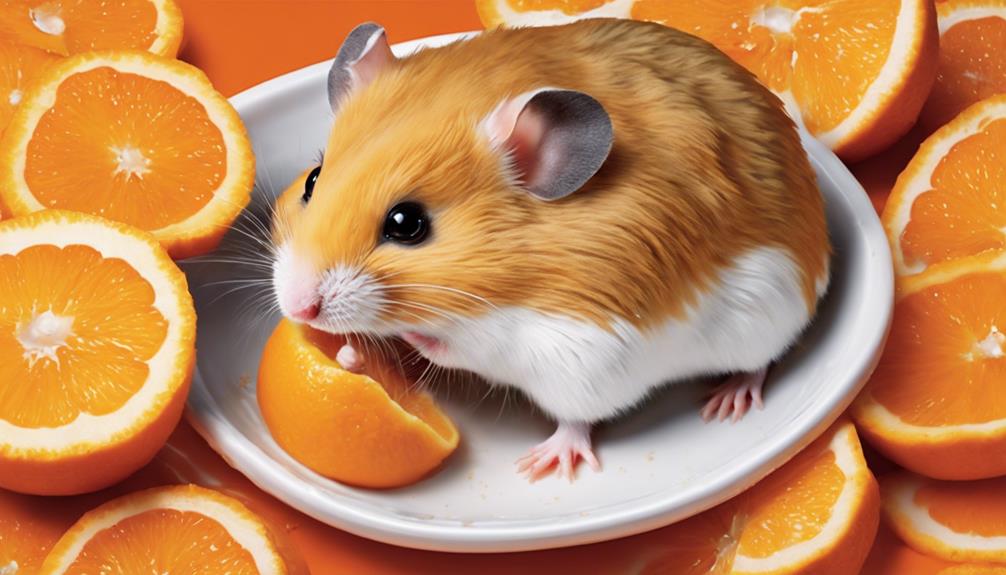
When feeding hamsters orange treats, it is important to be mindful of the potential impact on their health and digestion. While oranges provide essential vitamin C and fiber, their high acidity means moderation is crucial. To safely give oranges to hamsters, always remove seeds and peel, wash them thoroughly, and cut into small pieces to prevent choking. Keep a close eye on them for any adverse reactions such as stomach upset, and consider safer alternatives like apples or blueberries.
Remember, a balanced diet is vital for our hamsters' wellbeing.
Key Takeaways
- Choose safer alternatives like apples, carrots, blueberries, and strawberries for hamsters.
- Remove peel, seeds, and wash thoroughly before cutting oranges into small, bite-sized pieces.
- Monitor hamsters closely for signs of tummy distress like diarrhea after introducing oranges.
- Provide small portions of treats to prevent digestive issues and offer nutritional variety.
- Seek veterinary consultation if hamsters show adverse reactions to oranges for prompt care.
Benefits of Oranges for Hamsters
Oranges offer valuable benefits for hamsters, enriching their diet with essential vitamin C and natural sugars to support their immune system and provide a tasty treat. Vitamin C is crucial for hamsters as they can't produce it themselves, making oranges a great source to boost their immune system. The natural sugars in oranges can serve as a delightful occasional treat for hamsters, adding variety to their diet. Additionally, the fiber content in oranges can aid in digestion for these small creatures, promoting overall gut health.
When considering incorporating oranges into a hamster's diet, moderation is key. While oranges can be a healthy addition, they should be given in small, occasional pieces to prevent any digestive issues. Balancing treats like oranges with their regular pellet diet ensures that hamsters receive the necessary nutrients without overindulging. By offering oranges in moderation, hamsters can enjoy the benefits without compromising their overall well-being.
Safe Serving Sizes for Hamsters
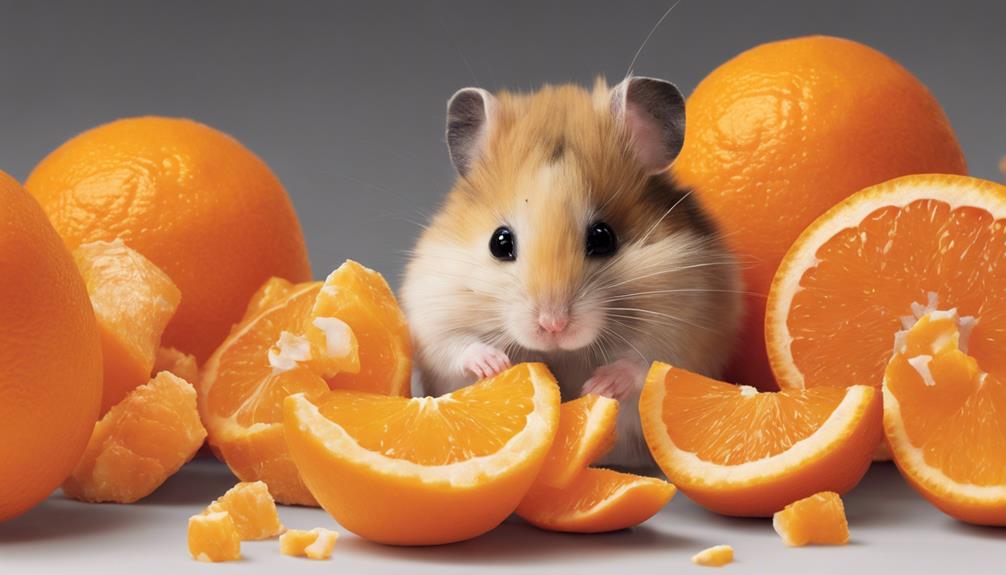
To ensure the well-being of your hamster, it is vital to understand the appropriate portion sizes when offering them treats. Hamsters love fruits, but when it comes to oranges, it's best to avoid them due to their high acidity that can upset your pet's tummy. Opt for safer alternatives like apples, carrots, blueberries, and strawberries to keep your hamster healthy and happy. When it comes to serving sizes, it's crucial to remember that hamsters are tiny creatures with small stomachs. Here's a simple guide to help you navigate the right portion sizes for your furry friend:
| Fruit Type | Serving Size |
|---|---|
| Apples | 1 small slice |
| Carrots | 1 baby carrot |
| Blueberries | 2-3 berries |
| Strawberries | 1 whole berry |
Preparing Oranges for Hamsters
When preparing oranges for hamsters, it's essential to thoroughly remove the peel and seeds to ensure their safety and well-being. Always wash the oranges thoroughly to eliminate any pesticides or residues that could be harmful to your furry friend.
Cut the oranges into small, bite-sized pieces to prevent choking hazards for hamsters. Due to the high acidity of oranges, it's crucial to limit these treats to occasional small portions.
Keep a close eye on your hamster and monitor for any signs of digestive issues after introducing oranges into their diet. By following these steps and preparing fresh oranges in the right way, you can offer your hamster a tasty and healthy treat that they'll enjoy.
Monitoring Hamster Reactions to Oranges
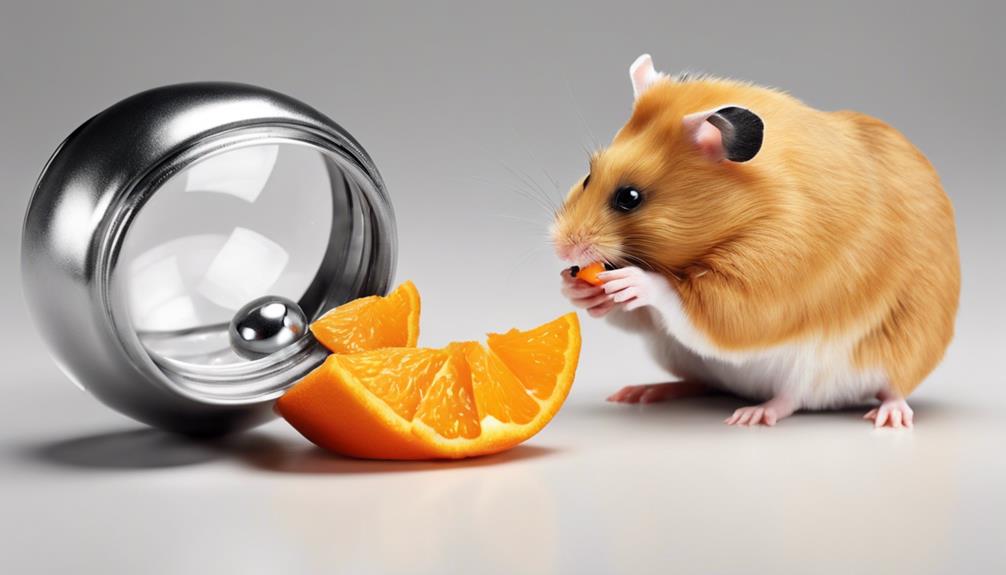
After properly preparing oranges for hamsters, it's important to closely monitor their reactions to the new treat to ensure their well-being and health. When introducing oranges as an occasional treat, observe any signs of tummy distress such as diarrhea, which could indicate digestive issues. Keep an eye on your hamster's appetite, behavior, and droppings for any changes after feeding oranges.
If you notice adverse effects or behavior changes, promptly remove oranges from their diet. It's crucial to document how your hamster responds to oranges to determine if they can safely enjoy this food. In case of any concerning symptoms, such as persistent digestive problems or unusual behavior, seek immediate veterinarian consultation.
Monitoring your hamster's reactions to oranges is essential in maintaining their well-being and ensuring that they can safely incorporate new foods into their diet.
Alternative Treat Options for Hamsters

Consider providing hamsters with a variety of safe treat options to add nutritional variety to their diet. Along with hamster mix, fresh fruits, and veggies, you can offer small pieces of unsweetened whole grain bread or plain cereals as treats. These options are safe for hamsters and can be given in moderation to prevent dietary issues.
For protein sources, consider occasional treats like cooked eggs or mealworms, which can help meet their dietary needs. Dwarf Hamsters, in particular, benefit from a diverse diet that includes different types of treats.
It's crucial to avoid sugary foods like sweets, chocolate, or high-sugar treats, as these can lead to health problems for hamsters. By including a mix of safe and nutritious treats in their diet, you can keep your hamster happy and healthy while providing them with a range of flavors and textures to enjoy.
Frequently Asked Questions
Can Hamsters Have Orange Treats?
We need to remember that hamsters shouldn't have orange treats or any citrus fruits. These fruits are too acidic and can lead to tummy issues and diarrhea in hamsters.
It's crucial to avoid giving them oranges, tangerines, lemons, or grapefruits as treats. Always put your hamster's digestive health first by steering clear of citrus fruits in their diet.
Prioritize their well-being and choose safer treat options for your furry friend.
What Treats Can Hamsters Eat?
We can offer hamsters a variety of treats such as sugarless breakfast cereals, greens, seeds, carrots, apples, raisins, peas, pepper, and cucumbers in moderation.
However, it's crucial to avoid dried fruits and vegetables high in sugar.
While these treats can be enjoyable, they should complement a balanced pelleted diet to ensure hamsters receive adequate nutrition.
Can I Feed My Hamster Sweets?
We should avoid feeding hamsters sweets to prevent health issues like obesity and digestive upset. Chocolate is toxic to them. Stick to nutritious treats like whole grain bread or small pieces of fruit.
Consult a vet before introducing new foods to your hamster. Remember, their well-being is our top priority. Let's ensure our furry friends stay healthy and happy by making smart choices when it comes to their diet.
How Often Should You Give Hamsters Treats?
We should give hamsters treats occasionally to maintain their balanced diet. It's essential to offer treats in small amounts to prevent digestive issues and obesity.
Monitoring our hamster's weight and overall health can help determine the frequency of treats. Typically, giving treats once or twice a week is sufficient for most hamsters.
Limiting treats is crucial to avoid health problems and ensure our furry friends stay happy and healthy.
Can I Feed My Hamster French Fries if They Can Safely Have Orange Treats?
Feeding hamsters french fries safely is not advisable, even if they can safely have orange treats. While it’s tempting to give your pet a taste of your snack, hamsters have specific dietary requirements. Stick to approved fruits and veggies for hamsters, and avoid giving them human food, such as french fries.
Conclusion
In conclusion, incorporating oranges into a hamster's diet can provide a tasty and nutritious treat. Remember to offer oranges in moderation and monitor your hamster's reaction closely.
By following safe serving sizes and properly preparing the fruit, you can ensure your furry friend enjoys this citrusy snack without any issues.
Remember, a happy hamster is as content as a clam in a cozy shell.
Laura is a versatile writer and editor whose passion for animals shines through in her work. With a keen understanding of language and a love for storytelling, Laura crafts compelling narratives that captivate our audience and inspire action regarding animal welfare. Whether she’s delving into the latest research or sharing heartwarming stories of animal companionship, Laura’s work will leave a lasting impression on all who read it.
Hamsters
How Hamsters Can Safely Eat Bell Peppers
Yearning to discover how hamsters can safely enjoy bell peppers without risking their health? Dive into our guide for essential tips and insights!
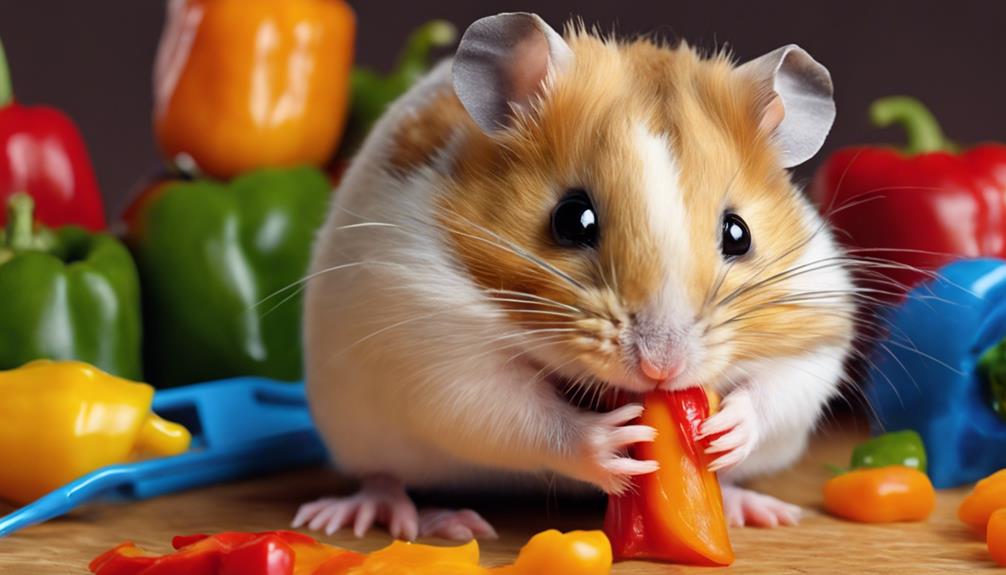
When feeding hamsters bell peppers, it is crucial to properly prepare and manage portion sizes for their health. Cut the bell peppers correctly, removing seeds and white parts, and chop into small pieces to prevent overeating. Give in moderation along with a well-rounded diet and make sure to wash thoroughly to remove any pesticides or dirt. Keep in mind, moderation is essential to prevent digestive problems, so follow recommended portion sizes and watch for signs of discomfort.
If you want to learn more about the benefits of bell peppers and potential risks, we've got you covered.
Key Takeaways
- Slice bell peppers into small, seedless chunks.
- Wash thoroughly to remove dirt and pesticides.
- Offer in moderation to prevent digestive issues.
- Monitor for any signs of distress or allergies.
- Provide a variety of colors for diverse nutrients.
Benefits of Bell Peppers for Hamsters
Bell peppers provide hamsters with essential vitamins A and C, ensuring their well-being and strengthening their immune system. These vibrant veggies aren't only delicious but also beneficial for a hamster's digestive system. The high fiber content in bell peppers supports digestion and promotes regular bowel movements in hamsters.
Moreover, the antioxidants present in bell peppers can enhance a hamster's immune system, decreasing the likelihood of illnesses. Including bell peppers in moderation in a hamster's diet supplies potassium and fiber, which are crucial for overall health and vitality.
Safe Preparation Methods

When preparing bell peppers for hamsters, make sure to wash them thoroughly under running water to eliminate any pesticides or dirt present on the surface. Here are some safe preparation methods to consider:
- Slice Bell Peppers Appropriately: Cut the bell peppers into small, bite-sized pieces for easy consumption by hamsters.
- Remove Seeds and White Parts: Eliminate the seeds and the white inner parts of the bell peppers to prevent choking hazards.
- Cut into Small Chunks: Ensure the bell peppers are cut into small chunks similar in size to two raisins to avoid overfeeding.
- Moderation is Key: Offer bell peppers to your hamster 2-3 times a week in moderation alongside a balanced diet to promote a proper bowel movement and prevent any risks associated with feeding bell peppers.
Recommended Bell Pepper Portions
To guarantee your hamster's well-being and health, it is important to carefully consider the recommended portions of bell peppers for their diet. When it comes to feeding bell peppers to your furry friend, moderation is key. Bell peppers might seem like a healthy snack, but they contain high water content that can lead to digestive issues if overfed. To prevent problems like diarrhea or upset stomachs, offer a piece of bell pepper approximately as long as the hamster's head. This portion size helps control their intake while still providing a tasty treat.
Here is a simple guide to help you understand how much bell pepper your hamster can safely enjoy:
| Type of Bell Pepper | Recommended Portion |
|---|---|
| Red Bell Pepper | Small piece |
| Green Bell Pepper | Small piece |
Types of Bell Peppers to Offer

For a well-rounded diet, consider providing a variety of colored bell peppers to your hamster. Here are the types of bell peppers to offer for your furry friend:
- Green Peppers: Green bell peppers are crunchy and slightly tangy, offering a revitalizing crunch to your hamster's diet. They contain a good amount of Vitamin C, crucial for your hamster's overall health.
- Red Bell Peppers: Sweeter and more flavorful than their green counterparts, red bell peppers are brimming with Vitamin C, making them a delicious and nutritious addition to your hamster's meals.
- Yellow Bell Peppers: Yellow bell peppers have a gentler flavor compared to red ones, adding a different taste profile to your hamster's palate. They also contribute to the colorful mix of nutrients your hamster needs.
- Orange Bell Peppers: With a slightly sweet taste, orange bell peppers provide a variety of nutrients and minerals, enhancing the diversity of your hamster's diet. Offering a mix of colors guarantees your hamster receives a range of vitamins and minerals for maximum health benefits.
Potential Risks to Consider

Considering the potential risks associated with consuming bell peppers, it's important to be mindful of certain factors when incorporating them into a hamster's diet.
Bell peppers have a high water content, so they should be fed in moderation to prevent diarrhea and upset stomach in hamsters. Some hamsters may be allergic to bell peppers, which can lead to adverse reactions such as vomiting or stomach aches.
Due to bell peppers being relatively high in phosphorus and low in calcium, serving them in small amounts is pivotal to avoid diet imbalances. When introducing any new food like bell peppers, it's crucial to monitor hamsters for signs of distress or digestive issues.
While bell peppers are generally safe for hamsters, overfeeding can be harmful, potentially causing dehydration and digestive discomfort. Hence, it's advisable to make sure that bell peppers are served in moderation to keep them safe and beneficial for hamsters.
Frequently Asked Questions
What Foods Are Poisonous to Hamsters?
Some foods poisonous to hamsters include garlic, onions causing anemia, chocolate with caffeine, raw beans, potatoes with harmful substances, almonds containing cyanide traces, and citrus fruits high in acidity. These items should be avoided to keep hamsters safe.
Are Bell Peppers Safe for Animals?
Yes, bell peppers are safe for animals. They contain essential nutrients like fiber and vitamins. Moderation is important to prevent health issues. Thoroughly washing and removing seeds before feeding is essential. Remember, too much can lead to problems.
What Fruits Are Not Good for Hamsters?
Certain fruits like grapes, citrus fruits, avocado, cherries with pits, and rhubarb are not recommended for hamsters due to sugar content, acidity, toxicity, cyanide in pits, and oxalic acid. It's crucial to avoid these for hamster safety.
Why Can't Hamsters Eat Garlic?
Garlic is harmful to hamsters due to compounds causing oxidative damage, potentially leading to anemia, digestive issues, and impaired oxygen transport. To keep our furry friends safe, garlic should be strictly avoided in their diet.
Can Bell Peppers and Zucchini be Part of a Hamster’s Safe Diet?
Yes, hamsters eating zucchini safely and bell peppers is acceptable. These veggies are high in nutrients and can be a part of a balanced hamster diet. However, remember to feed them in moderation and remove any uneaten portions to prevent spoilage. Always consult a vet for dietary advice.
Conclusion
To sum up, bell peppers can make a nutritious addition to a hamster's diet when offered in moderation and prepared safely. By following the recommended portion sizes and choosing the right type of bell peppers, you can provide your furry friend with a tasty and healthy treat.
Remember to always monitor your hamster's reaction to new foods and consult with a veterinarian if you have any concerns. Your hamster will thank you for the delicious and nutritious snack!
Paul’s love for animals knows no bounds. As a dedicated writer and animal lover, Paul brings a unique perspective to our team. His firsthand experiences with various animals enrich our content and provide valuable insights into their behavior and needs. Whether he’s sharing tips for pet care or shedding light on pressing conservation issues, Paul’s passion for animals shines through in everything he does.
-

 Vetted2 months ago
Vetted2 months ago15 Best Cat Foods for Managing Hyperthyroidism – Vet Approved and Feline Friendly
-

 Vetted2 months ago
Vetted2 months ago15 Best Dog Foods for Kidney Disease – Expert Recommendations for Your Pet's Health
-

 Vetted2 months ago
Vetted2 months ago15 Best Wet Cat Foods for Older Cats to Keep Them Healthy and Happy
-

 Vetted2 months ago
Vetted2 months ago15 Best Fresh Dog Food Delivery Services for Your Pup's Health and Happiness
-

 Vetted2 months ago
Vetted2 months ago14 Best Homemade Dog Food Recipes Your Pup Will Love – Vet Approved & Nutritious
-

 Animal Facts2 months ago
Animal Facts2 months agoSpring Animals: A Guide to Seasonal Wildlife
-

 Cats1 month ago
Cats1 month agoCat Weight Chart by Age: Kitten to Senior in Lbs
-

 Cats2 weeks ago
Cats2 weeks agoTop 5 Cat Breeders in Arkansas: A Guide






















